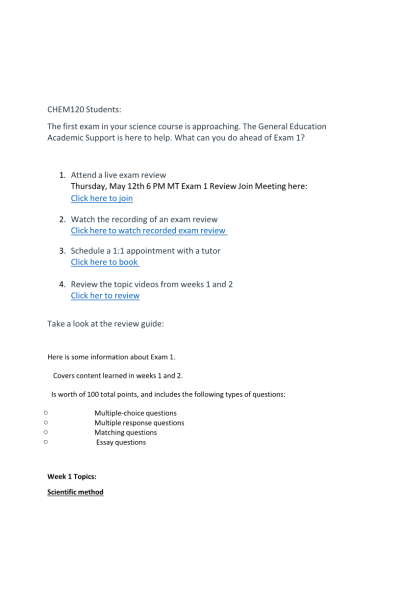The first exam in your science course is approaching. The General Education Academic Support is here to help. What can you do ahead of Exam 1?
Here issome information about Exam 1.
Covers content learned in weeks 1 and 2.
Is worth of 100 total points, and includes the following types of questions:
- Multiple-choice questions
- Multiple response questions
- Matching questions
- Essay questions
Week 1 Topics: Scientific method
Hypothesis: A testable explanation.
Independent variable: What you as the scientist are controlling or changing.
Dependent variable: Depends on the independent variable. What you expect to change. What you are measuring.
Positive control: Group or condition with known outcome. Negative control: Condition for which no change is expected. Experimental controls: All the conditions that are held constant. Sample question:
Q1. You have observed that your heart rate increases upon exercise, having caffeine and when you are scared. You want to conduct a study and of these which one is easily controllable independent variable?
Q2. You want to test two pain killer drugs A and B for their effectiveness in treating headaches. Based on the literature available and the chemical composition of the drugs you think drug A is more effective than B. You would like to determine which one is the most effective. State your hypothesis, design an experiment, and state a result that would support your hypothesis.
Remember to include positive and negative controls. What is the independent and dependent variable of this experiment? Name the constant variables of this experiment. (8 points)
Q 3. I am studying the effect of exercise on heart rate. Which will be the independent variable of this experiment.
Dimensional Analysis
- Always set up your start and end point before using conversions
Examples:
- I have a book with a weight of 0.46 lbs. What is the mass of this book in kg?
- I have a sample of a fluid with a volume of 670 ml. What is the volume of this sample in gal?
- I have a sample that diffused to a diameter of 0.2 inches. What is this diameter in mm?
Do not forget about density!
Q1. In an experiment, you calculate that the mass of a 95.5 ml sample of a liquid is 75 grams. You know that this liquid is one of the substances below: Which liquid do you have?
Q 2: If a silver nugget occupies a volume of 8 ml what will be the mass of this metal? (density of silver is 10.5 g/ml).
What do we know about atoms?
Subatomic particles and their relationships
Applications:
- I have an isotope with an atomic number of 48 and a mass number of 130. How many protons, electrons, and neutrons would I expect this atom to have, and what is this element?
- I have an isotope of Oxygen with 9 neutrons. What is the mass number of this isotope?
- What is the mass number of a Ti isotope with 46 neutrons?
What do we know about ions?
- Charged particle (atom or molecule)
- Ions arise from an imbalance of protons and electrons due to the loss or gain of electrons
- Cations have a positive charge
- Anions have an negative charge
- Ions form to have a more stable, Nobel gas like configuration (8 valance electrons)
- They form to be like the nearest Nobel gas
- Are great electrical conductors
Applications:
- What would be the charge of an ion of oxygen?
- What would be the electron configuration of an Mg ion?
- Determine which ion has the ground-state electron configuration of:
- How many valance electrons (outermost electrons) will each of the following have?
- An ion has 12 neutrons, 11 protons, and 10 electrons. What is the charge of this ion?
- Use your understanding of ions and ground-state atoms to determine how many electrons you would expect each of the following species to contain:
Compounds:
Application
- Select all the substances that have ionic bonds
- ..
- An atom of Al reacts with an atom of Sulfur. Al 3 + and S 2- ions are formed and the two atoms form an ionic compound: Al2S3. In this reaction, the Sulfur atom:
Molecular Compounds or Covalent Compounds
Molecular or covalent compounds contain two or more nonmetal ions and are named by using prefixes such as di, tri, tetra, etc. try to name the following. H2S, NO2, CO2, CO, P2S5, Cl2O5, N2S3, NH4 +
Sample questions:
- The name of the compound Cl2O5 is
- The bond between two oxygen atoms would best be described as a(n)
Polarity:
These terms are only, ONLY, used for covalent bonds. NOT IONIC Polar: Unequal sharing
Nonpolar: Equal sharing
- Which of the below contains a polar bond? Select all that apply.
- What are hydrogen bonds?
Application
- Which of the following species would you expect to form intermolecular hydrogen bonds?
Examples:
Determine which of the following would have the greater ionization energy:
Electron configuration:
This tells us where the electrons in an atom are residing.
- Superscript: number of electrons currently in that sublevel.
Determine the electron configurations of each of the following and determine the number of valance electrons:
| Instituition / Term | |
| Term | Spring |
| Institution | Chamberlain |
| Contributor | Mary Joy |
























